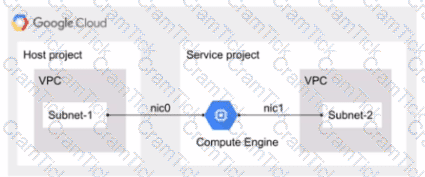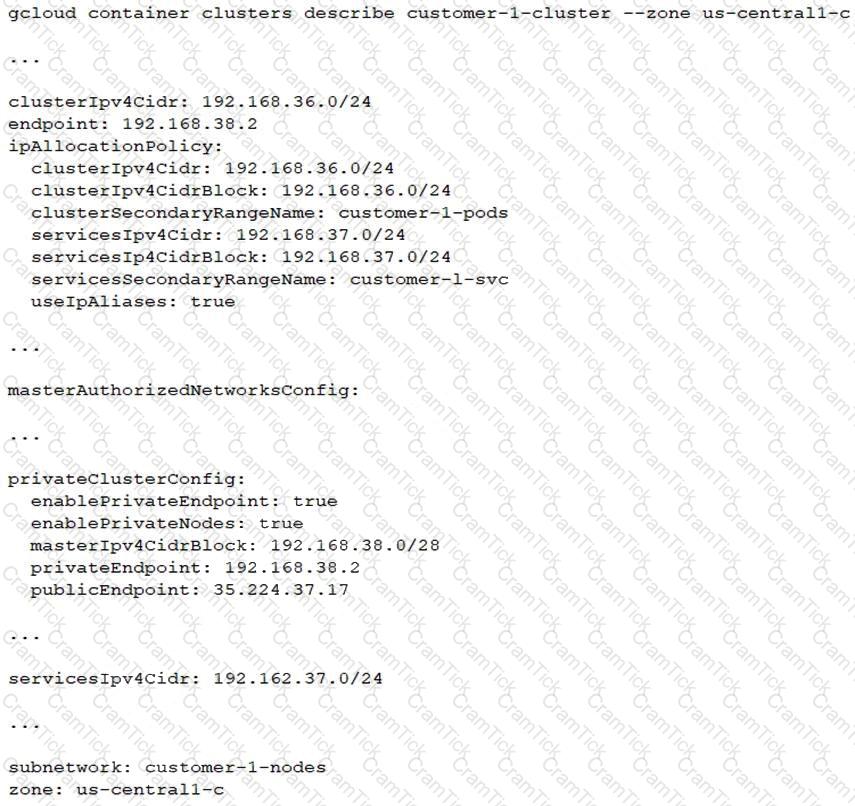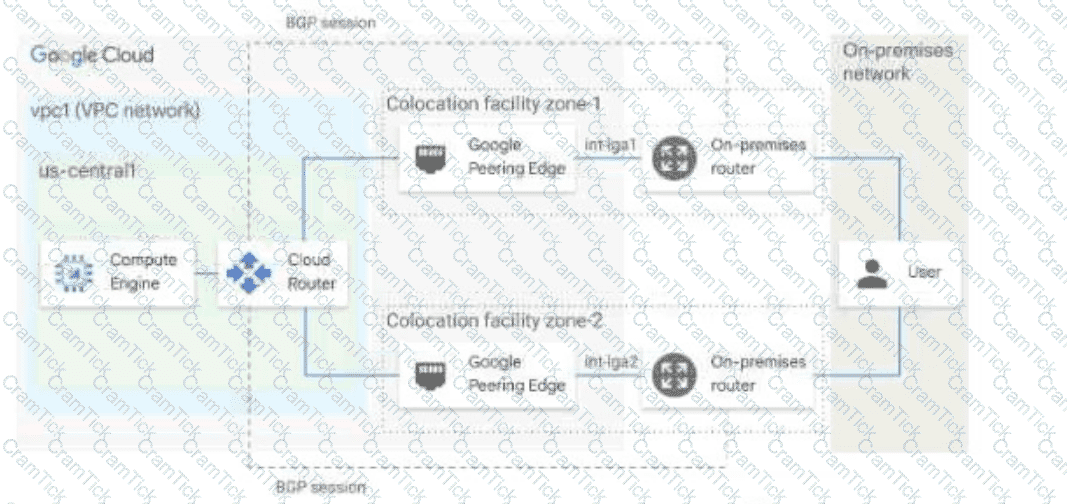Question:
Your organization's security team recently discovered that there is a high risk of malicious activities originating from some of your VMs connected to the internet. These malicious activities are currently undetected when TLS communication is used. You must ensure that encrypted traffic to the internet is inspected. What should you do?
You have created a firewall with rules that only allow traffic over HTTP, HTTPS, and SSH ports. While testing, you specifically try to reach the server over multiple ports and protocols; however, you do not see any denied connections in the firewall logs. You want to resolve the issue.
What should you do?
You want Cloud CDN to serve the https://www.example.com/images/spacetime.png static image file that is hosted in a private Cloud Storage bucket, You are using the VSE ORIG.-X_NZADERS cache mode You receive an HTTP 403 error when opening the file In your browser and you see that the HTTP response has a Cache-control: private, max-age=O header How should you correct this Issue?
Your company's on-premises office is connected to Google Cloud using HA VPN. The security team will soon enable VPC Service Controls. You need to create a plan with minimal configuration adjustments, so clients at the office will still be able to privately call the Google APIs and be protected by VPC Service Controls. What should you do?
(You are developing an internet of things (IoT) application that captures sensor data from multiple devices that have already been set up. You need to identify the global data storage product your company should use to store this data. You must ensure that the storage solution you choose meets your requirements of sub-millisecond latency. What should you do?)
Your end users are located in close proximity to us-east1 and europe-west1. Their workloads need to communicate with each other. You want to minimize cost and increase network efficiency.
How should you design this topology?
Question:
Your multi-region VPC has had a long-standing HA VPN configured in "region 1" connected to your corporate network. You are planning to add two 10 Gbps Dedicated Interconnect connections and VLAN attachments in "region 2" to connect to the same corporate network. You need to plan for connectivity between your VPC and corporate network to ensure that traffic uses the Dedicated Interconnect connections as the primary path and the HA VPN as the secondary path. What should you do?
You have the following Shared VPC design VPC Flow Logs is configured for Subnet-1 In the host VPC. You also want to monitor flow logs for Subnet-2. What should you do?

You have several microservices running in a private subnet in an existing Virtual Private Cloud (VPC). You need to create additional serverless services that use Cloud Run and Cloud Functions to access the microservices. The network traffic volume between your serverless services and private microservices is low. However, each serverless service must be able to communicate with any of your microservices. You want to implement a solution that minimizes cost. What should you do?
You are using a 10-Gbps direct peering connection to Google together with the gsutil tool to upload files to Cloud Storage buckets from on-premises servers. The on-premises servers are 100 milliseconds away from the Google peering point. You notice that your uploads are not using the full 10-Gbps bandwidth available to you. You want to optimize the bandwidth utilization of the connection.
What should you do on your on-premises servers?
Your on-premises data center has 2 routers connected to your GCP through a VPN on each router. All applications are working correctly; however, all of the traffic is passing across a single VPN instead of being load-balanced across the 2 connections as desired.
During troubleshooting you find:
•Each on-premises router is configured with the same ASN.
•Each on-premises router is configured with the same routes and priorities.
•Both on-premises routers are configured with a VPN connected to a single Cloud Router.
•The VPN logs have no-proposal-chosen lines when the VPNs are connecting.
•BGP session is not established between one on-premises router and the Cloud Router.
What is the most likely cause of this problem?
You want to configure load balancing for an internet-facing, standard voice-over-IP (VOIP) application.
Which type of load balancer should you use?
Your company has defined a resource hierarchy that includes a parent folder with subfolders for each department. Each department defines their respective project and VPC in the assigned folder and has the appropriate permissions to create Google Cloud firewall rules. The VPCs should not allow traffic to flow between them. You need to block all traffic from any source, including other VPCs, and delegate only the intra-VPC firewall rules to the respective departments. What should you do?
In your project my-project, you have two subnets in a Virtual Private Cloud (VPC): subnet-a with IP range 10.128.0.0/20 and subnet-b with IP range 172.16.0.0/24. You need to deploy database servers in subnet-a. You will also deploy the application servers and web servers in subnet-b. You want to configure firewall rules that only allow database traffic from the application servers to the database servers. What should you do?
You have an application that is running in a managed instance group. Your development team has released an updated instance template which contains a new feature which was not heavily tested. You want to minimize impact to users if there is a bug in the new template.
How should you update your instances?
You have an application running on Compute Engine that uses BigQuery to generate some results that are stored in Cloud Storage. You want to ensure that none of the application instances have external IP addresses.
Which two methods can you use to accomplish this? (Choose two.)
Your organization is running out of private IPv4 IP addresses. You need to create a new design pattern to reduce IP usage in your Google Kubernetes Engine clusters. Each new GKE cluster should have a unique /24 range of routable RFC1918 IP addresses. What should you do?
You have ordered Dedicated Interconnect in the GCP Console and need to give the Letter of Authorization/Connecting Facility Assignment (LOA-CFA) to your cross-connect provider to complete the physical connection.
Which two actions can accomplish this? (Choose two.)
Your company has recently installed a Cloud VPN tunnel between your on-premises data center and your Google Cloud Virtual Private Cloud (VPC). You need to configure access to the Cloud Functions API for your on-premises servers. The configuration must meet the following requirements:
Certain data must stay in the project where it is stored and not be exfiltrated to other projects.
Traffic from servers in your data center with RFC 1918 addresses do not use the internet to access Google Cloud APIs.
All DNS resolution must be done on-premises.
The solution should only provide access to APIs that are compatible with VPC Service Controls.
What should you do?
You have created an HTTP(S) load balanced service. You need to verify that your backend instances are responding properly.
How should you configure the health check?
You recently deployed two network virtual appliances in us-central1. Your network appliances provide connectivity to your on-premises network, 10.0.0.0/8. You need to configure the routing for your Virtual Private Cloud (VPC). Your design must meet the following requirements:
All access to your on-premises network must go through the network virtual appliances.
Allow on-premises access in the event of a single network virtual appliance failure.
Both network virtual appliances must be used simultaneously.
Which method should you use to accomplish this?
You created a new VPC for your development team. You want to allow access to the resources in this VPC via SSH only.
How should you configure your firewall rules?
You need to restrict access to your Google Cloud load-balanced application so that only specific IP addresses can connect.
What should you do?
You are responsible for configuring firewall policies for your company in Google Cloud. Your security team has a strict set of requirements that must be met to configure firewall rules.
Always allow Secure Shell (SSH) from your corporate IP address.
Restrict SSH access from all other IP addresses.
There are multiple projects and VPCs in your Google Cloud organization. You need to ensure that other VPC firewall rules cannot bypass the security team’s requirements. What should you do?
You are configuring load balancing for a standard three-tier (web, application, and database) application. You have configured an external HTTP(S) load balancer for the web servers. You need to configure load balancing for the application tier of servers. What should you do?
You have configured Cloud CDN using HTTP(S) load balancing as the origin for cacheable content. Compression is configured on the web servers, but responses served by Cloud CDN are not compressed.
What is the most likely cause of the problem?
Your organization recently re-architected your cloud environment to use Network Connectivity Center. However, an error occurred when you tried to add a new VPC named vpc-dev as a spoke. The error indicated that there was an issue with an existing spoke and the IP space of a VPC named vpc-pre-prod. You must complete the migration quickly and efficiently. What should you do?
You have the following private Google Kubernetes Engine (GKE) cluster deployment:

You have a virtual machine (VM) deployed in the same VPC in the subnetwork kubernetes-management with internal IP address 192.168.40 2/24 and no external IP address assigned. You need to communicate with the cluster master using kubectl. What should you do?
You are designing an IP address scheme for new private Google Kubernetes Engine (GKE) clusters. Due to IP address exhaustion of the RFC 1918 address space In your enterprise, you plan to use privately used public IP space for the new clusters. You want to follow Google-recommended practices. What should you do after designing your IP scheme?
Your company has a Virtual Private Cloud (VPC) with two Dedicated Interconnect connections in two different regions: us-west1 and us-east1. Each Dedicated Interconnect connection is attached to a Cloud Router in its respective region by a VLAN attachment. You need to configure a high availability failover path. By default, all ingress traffic from the on-premises environment should flow to the VPC using the us-west1 connection. If us-west1 is unavailable, you want traffic to be rerouted to us-east1. How should you configure the multi-exit discriminator (MED) values to enable this failover path?
You have recently been put in charge of managing identity and access management for your organization. You have several projects and want to use scripting and automation wherever possible. You want to grant the editor role to a project member.
Which two methods can you use to accomplish this? (Choose two.)
Question:
Your organization has a new security policy that requires you to monitor all egress traffic payloads from your virtual machines in the us-west2 region. You deployed an intrusion detection system (IDS) virtual appliance in the same region to meet the new policy. You now need to integrate the IDS into the environment to monitor all egress traffic payloads from us-west2. What should you do?
Question:
You are troubleshooting connectivity issues between Google Cloud and a public SaaS provider. Connectivity between the two environments is through the public internet. Your users are reporting intermittent connection errors when using TCP to connect; however, ICMP tests show no failures. According to users, errors occur around the same time every day. You want to troubleshoot and gather information by using Google Cloud tools that are most likely to provide insights into what is occurring within Google Cloud. What should you do?
Your company offers a popular gaming service. Your instances are deployed with private IP addresses, and external access is granted through a global load balancer. You believe you have identified a potential malicious actor, but aren't certain you have the correct client IP address. You want to identify this actor while minimizing disruption to your legitimate users.
What should you do?
You have deployed a new internal application that provides HTTP and TFTP services to on-premises hosts. You want to be able to distribute traffic across multiple Compute Engine instances, but need to ensure that clients are sticky to a particular instance across both services.
Which session affinity should you choose?
You create multiple Compute Engine virtual machine instances to be used as TFTP servers.
Which type of load balancer should you use?
Question:
Your organization wants to deploy HA VPN over Cloud Interconnect to ensure encryption in transit over the Cloud Interconnect connections. You have created a Cloud Router and two encrypted VLAN attachments that have a 5 Gbps capacity and a BGP configuration. The BGP sessions are operational. You need to complete the deployment of the HA VPN over Cloud Interconnect. What should you do?
You are configuring a new HTTP application that will be exposed externally behind both IPv4 and IPv6 virtual IP addresses, using ports 80, 8080, and 443. You will have backends in two regions: us-west1 and us-east1. You want to serve the content with the lowest-possible latency while ensuring high availability and autoscaling, and create native content-based rules using the HTTP hostname and request path. The IP addresses of the clients that connect to the load balancer need to be visible to the backends. Which configuration should you use?
Question:
Your organization recently exposed a set of services through a global external Application Load Balancer. After conducting some testing, you observed that responses would intermittently yield a non-HTTP 200 response. You need to identify the error. What should you do? (Choose 2 answers)
You have an HA VPN connection with two tunnels running in active/passive mode between your Virtual Private Cloud (VPC) and on-premises network. Traffic over the connection has recently increased from 1 gigabit per second (Gbps) to 4 Gbps, and you notice that packets are being dropped. You need to configure your VPN connection to Google Cloud to support 4 Gbps. What should you do?
You are disabling DNSSEC for one of your Cloud DNS-managed zones. You removed the DS records from your zone file, waited for them to expire from the cache, and disabled DNSSEC for the zone. You receive reports that DNSSEC validating resolves are unable to resolve names in your zone.
What should you do?
You configured a single IPSec Cloud VPN tunnel for your organization to a third-party customer. You confirmed that the VPN tunnel is established; however, the BGP session status states that BGP is not configured. The customer has provided you with their BGP settings:
Local BGP address: 169.254.11.1/30
Local ASN: 64515
Peer BGP address: 169.254.11.2
Peer ASN: 64517
Base MED: 1000
MD5 Authentication: Disabled
You need to configure the local BGP session for this tunnel based on the settings provided by the customer. You already associated the Cloud Router with the Cloud VPN Tunnel. What settings should you use for the BGP session?
You want to use Partner Interconnect to connect your on-premises network with your VPC. You already have an Interconnect partner.
What should you first?
You want to apply a new Cloud Armor policy to an application that is deployed in Google Kubernetes Engine (GKE). You want to find out which target to use for your Cloud Armor policy.
Which GKE resource should you use?
Your company is planning a migration to Google Kubernetes Engine. Your application team informed you that they require a minimum of 60 Pods per node and a maximum of 100 Pods per node Which Pod per node CIDR range should you use?
You want to set up two Cloud Routers so that one has an active Border Gateway Protocol (BGP) session, and the other one acts as a standby.
Which BGP attribute should you use on your on-premises router?
You need to define an address plan for a future new GKE cluster in your VPC. This will be a VPC native cluster, and the default Pod IP range allocation will be used. You must pre-provision all the needed VPC subnets and their respective IP address ranges before cluster creation. The cluster will initially have a single node, but it will be scaled to a maximum of three nodes if necessary. You want to allocate the minimum number of Pod IP addresses.
Which subnet mask should you use for the Pod IP address range?
Your company has a single Virtual Private Cloud (VPC) network deployed in Google Cloud with on-premises connectivity already in place. You are deploying a new application using Google Kubernetes Engine (GKE), which must be accessible only from the same VPC network and on-premises locations. You must ensure that the GKE control plane is exposed to a predefined list of on-premises subnets through private connectivity only. What should you do?
In order to provide subnet level isolation, you want to force instance-A in one subnet to route through a security appliance, called instance-B, in another subnet.
What should you do?
You need to ensure your personal SSH key works on every instance in your project. You want to accomplish this as efficiently as possible.
What should you do?
You are creating a new application and require access to Cloud SQL from VPC instances without public IP addresses.
Which two actions should you take? (Choose two.)
In your Google Cloud organization, you have two folders: Dev and Prod. You want a scalable and consistent way to enforce the following firewall rules for all virtual machines (VMs) with minimal cost:
Port 8080 should always be open for VMs in the projects in the Dev folder.
Any traffic to port 8080 should be denied for all VMs in your projects in the Prod folder.
What should you do?
Your company’s Google Cloud-deployed, streaming application supports multiple languages. The application development team has asked you how they should support splitting audio and video traffic to different backend Google Cloud storage buckets. They want to use URL maps and minimize operational overhead. They are currently using the following directory structure:
/fr/video
/en/video
/es/video
/../video
/fr/audio
/en/audio
/es/audio
/../audio
Which solution should you recommend?
You have the networking configuration shown in the diagram. A pair of redundant Dedicated Interconnect connections (int-Igal and int-Iga2) terminate on the same Cloud Router. The Interconnect connections terminate on two separate on-premises routers. You are advertising the same prefixes from the Border Gateway Protocol (BGP) sessions associated with the Dedicated Interconnect connections. You need to configure one connection as Active for both ingress and egress traffic. If the active Interconnect connection fails, you want the passive Interconnect connection to automatically begin routing all traffic Which two actions should you take to meet this requirement? (Choose Two)

You recently deployed Compute Engine instances in regions us-west1 and us-east1 in a Virtual Private Cloud (VPC) with default routing configurations. Your company security policy mandates that virtual machines (VMs) must not have public IP addresses attached to them. You need to allow your instances to fetch updates from the internet while preventing external access. What should you do?
Question:
You are designing the architecture for your organization so that clients can connect to certain Google APIs. Your plan must include a way to connect to Cloud Storage and BigQuery. You also need to ensure the traffic does not traverse the internet. You want your solution to be cloud-first and require the least amount of configuration steps. What should you do?
You recently deployed Cloud VPN to connect your on-premises data center to Google Cloud. You need to monitor the usage of this VPN and set up alerts in case traffic exceeds the maximum allowed. You need to be able to quickly decide whether to add extra links or move to a Dedicated Interconnect. What should you do?
You have deployed an HTTP(s) load balancer, but health checks to port 80 on the Compute Engine virtual machine instance are failing, and no traffic is sent to your instances. You want to resolve the problem. Which commands should you run?
Your organization has Compute Engine instances in us-east1, us-west2, and us-central1. Your organization also has an existing Cloud Interconnect physical connection in the East Coast of the United States with a single VLAN attachment and Cloud Router in us-east1. You need to provide a design with high availability and ensure that if a region goes down, you still have access to all your other Virtual Private Cloud (VPC) subnets. You need to accomplish this in the most cost-effective manner possible. What should you do?
Your organization's security policy requires that all internet-bound traffic return to your on-premises data center through HA VPN tunnels before egressing to the internet, while allowing virtual machines (VMs) to leverage private Google APIs using private virtual IP addresses 199.36.153.4/30. You need to configure the routes to enable these traffic flows. What should you do?
You have the following firewall ruleset applied to all instances in your Virtual Private Cloud (VPC):

You need to update the firewall rule to add the following rule to the ruleset:

You are using a new user account. You must assign the appropriate identity and Access Management (IAM) user roles to this new user account before updating the firewall rule. The new user account must be able to apply the update and view firewall logs. What should you do?
You are responsible for designing a new connectivity solution between your organization's on-premises data center and your Google Cloud Virtual Private Cloud (VPC) network Currently, there Is no end-to-end connectivity. You must ensure a service level agreement (SLA) of 99.99% availability What should you do?
You are planning a large application deployment in Google Cloud that includes on-premises connectivity. The application requires direct connectivity between workloads in all regions and on-premises locations without address translation, but all RFC 1918 ranges are already in use in the on-premises locations. What should you do?
You want to use Cloud Interconnect to connect your on-premises network to a GCP VPC. You cannot meet Google at one of its point-of-presence (POP) locations, and your on-premises router cannot run a Border Gateway Protocol (BGP) configuration.
Which connectivity model should you use?
You need to establish network connectivity between three Virtual Private Cloud networks, Sales, Marketing, and Finance, so that users can access resources in all three VPCs. You configure VPC peering between the Sales VPC and the Finance VPC. You also configure VPC peering between the Marketing VPC and the Finance VPC. After you complete the configuration, some users cannot connect to resources in the Sales VPC and the Marketing VPC. You want to resolve the problem.
What should you do?
Your on-premises data center has 2 routers connected to your Google Cloud environment through a VPN on each router. All applications are working correctly; however, all of the traffic is passing across a single VPN instead of being load-balanced across the 2 connections as desired.
During troubleshooting you find:
• Each on-premises router is configured with a unique ASN.
• Each on-premises router is configured with the same routes and priorities.
• Both on-premises routers are configured with a VPN connected to a single Cloud Router.
• BGP sessions are established between both on-premises routers and the Cloud Router.
• Only 1 of the on-premises router’s routes are being added to the routing table.
What is the most likely cause of this problem?
Google Cloud Platform | Professional-Cloud-Network-Engineer Questions Answers | Professional-Cloud-Network-Engineer Test Prep | Google Cloud Certified - Professional Cloud Network Engineer Questions PDF | Professional-Cloud-Network-Engineer Online Exam | Professional-Cloud-Network-Engineer Practice Test | Professional-Cloud-Network-Engineer PDF | Professional-Cloud-Network-Engineer Test Questions | Professional-Cloud-Network-Engineer Study Material | Professional-Cloud-Network-Engineer Exam Preparation | Professional-Cloud-Network-Engineer Valid Dumps | Professional-Cloud-Network-Engineer Real Questions | Google Cloud Platform Professional-Cloud-Network-Engineer Exam Questions


